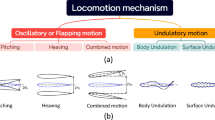Summary
Penguins (Pygoscelis papua) swimming parallel to the glass screen of a large aquarium in Zoologischer Garten, Frankfurt, were filmed during deceleration phases during which their extremities were not moved relative to the trunk. Drag coefficients were determined using a newly developed method of analysis (the reciprocal value of velocity plotted as a function of time gives a linear curve during undisturbed deceleration). The frontal drag coefficient is 7·10−2, surface drag coefficient 4.4·10−3 and volume drag coefficient 3.1·10−2. The ratio of length to diameter is 4.2. The length from head to broadest part of trunk relative to body length is 0.48. These results are compared with technical hydro- and aerodynamic measurements found in literature. The body form of penguins appears to be well adapted to transporting unit mass with least resistance. Their frontal and volume drag coefficients cannot be further improved. The surface drag coefficient shows that, at Reynolds numbers of deceleration swimming (Re≈106), unusual effects need not be taken into account. This indicates that the boundary layer is partly laminar, partly turbulent as found in optimally stream-lined technical objects. We suppose that the smooth feathered surface of a penguin dampens boundary layer oscillations especially during fast swimming at Reynolds numbers of 107 and guarantees laminar flow over larger regions of the trunk.
Similar content being viewed by others
Literatur
Clark, B.D., Bemis, W.: Kinematics of swimming of penguins at the Detroit Zoo. J. Zool. (London)188, 411–428 (1979)
Eck, B.: Technische Strömungslehre, 7. Aufl. Berlin, Heidelberg, New York: Springer 1966
Gilliard, E., Steinbacher, G.: Knaur's Tierreich in Farben: Vögel. München: Droemer'sche Verlagsanstalt 1959
Hertel, H.: Biologie und Technik. Mainz: Krausskopf 1963
Hoerner, S.F.: Fluid dynamic drag. Hoerner fluid dynamics. Brick Town, NY 1965
Kempf, G., Neu, W.: Schleppversuche mit Hechten zur Messung des Wasserwiderstandes. Z. Vergl. Physiol.17, 353–364 (1932)
Koenig-Fachsenfeld, R.: Aerodynamik des Kraftfahrzeugs. Frankfurt: Umschau 1951
Kramer, M.O.: The dolphins secret. New Sci.7, 1118–1120 (1960)
Nachtigall, W.: Locomotion: mechanics and hydrodynamics of swimming in aquatic insects. In: The physiology of insecta, Vol. III, 2nd ed. Rockstein, M. (ed.). New York, London: Academic Press 1974
Nachtigall, W.: Zur Bedeutung der Reynoldszahl und der damit zusammenhängenden strömungsmechanischen Phänomene in der Schwimmphysiologie und Flugbiophysik. Fortschr. Zool.24 (2/3), 13–56 (1977)
Nachtigall, W., Bilo, D.: Die Strömungsmechanik desDytiscus-Rumpfes. Z. Vergl. Physiol.50, 371–401 (1965)
Ohlmer, W.: Untersuchungen über die Beziehungen zwischen Körperform und Bewegungsmedium bei Fischen aus stehenden Binnengewässern. Zool. Jahrb. Abt. Anat. Ontog. Tiere81, 151–240 (1964)
Truckenbrodt, E.: Strömungsmechanik. Berlin, Heidelberg, New York: Springer 1968
Ungerechts, B.: Windkanalmessungen an einem starren Haifischmodell bei hohen Reynolds-Zahlen. Fortschr. Zool.24 (2/3), 177–181 (1977)
Author information
Authors and Affiliations
Rights and permissions
About this article
Cite this article
Nachtigall, W., Bilo, D. Strömungsanpassung des Pinguins beim Schwimmen unter Wasser. J. Comp. Physiol. 137, 17–26 (1980). https://doi.org/10.1007/BF00656913
Accepted:
Issue Date:
DOI: https://doi.org/10.1007/BF00656913




